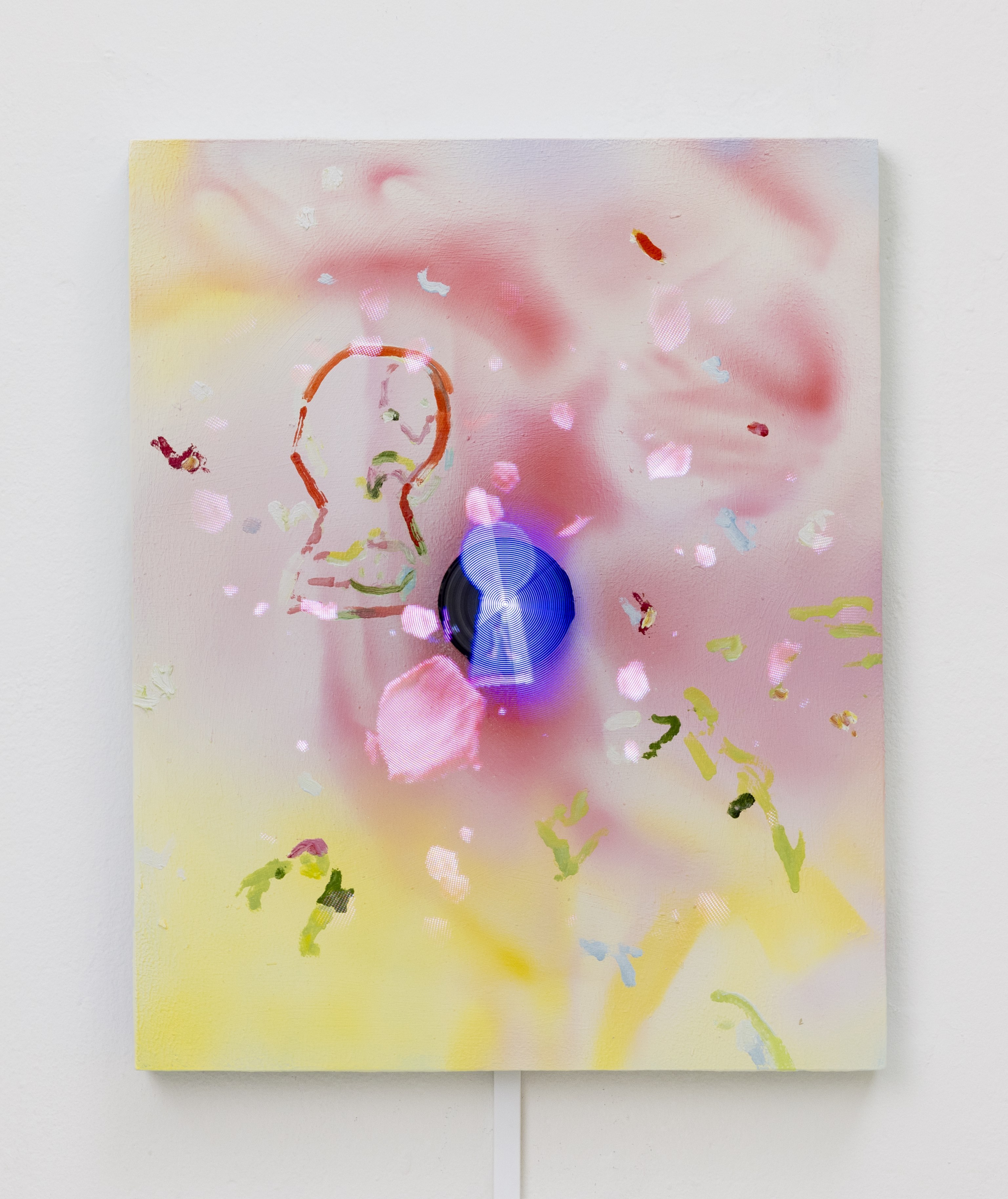December 2022
Geoffrey Mak
Signs and wonders
Rachel Rossin is obsessed with the Defense Advanced Research Projects Agencyan agency of the United States Department of Defense responsible for the development of emerging technologies for use by the military. “I like to keep up to date with what DARPA is doing,” she told me. “I like to figure out how to prepare myself for what’s coming.” We were talking about “stingrays” – briefcase-sized surveillance devices used by the New York Police Department to hack data, like phone numbers and call histories, from cell phones in the area by mimicking the functions of cell phone towers, which typically provide reception. During the Black Lives Matter protests, Rossin noticed that whenever a helicopter came close, her cell phone bars would go from one to four. As a self-taught hacker since she was a teenager, she wanted to know why: “I inverted the signal from my laptop, went through my phone, and got the MAC [media access control] address for this stingray. And sure enough, I saw where it was manufactured, and that the NYPD owned it.”
Rossin speaks with the restrained affect of a young professor, knowing and patient. She has an angled jaw and pulled-back wavy hair that makes her look, at times, like a young Angelina Jolie. In conversation, she weaves from Hannah Arendt to science fiction to brain implants sponsored by the military. If her interest in nefarious, mind-control technologies comes as a surprise, it’s because her oil paintings are really, really pretty. They often show plants in vibrant colours, with cascading petals one might find in shoujo anime. They put her in company with a crop of new media formalists, like Petra Cortright and Katherine Frazer, who have made works for screens and canvases that depict flowers in various stages of deconstruction that happen in the slippage between haptic artmaking and digital rendering.
Although, Rossin isn’t really a formalist. She’s a deft oil painter who also happens to know Rhino, Maya, Cinema 4D, Unity, and other 3D rendering software. She traverses not only media and formats, but across layered realities, from the embodied to the virtual. Since 2017, Rossin has created what she calls “hologram-combines”, each of which consists of a painting with an electrically powered zoetrope embedded on top. As an update of the 19th-century zoetrope, which was one of the earliest moving-image technologies, Rossin’s programmed LED fans effectively superimpose animations across the surface of the paintings. It draws a striking continuity from the moving image at its inception up to its contemporary form in augmented reality (AR) technologies, which she also actively uses across her work. This terrifying zip of history, so fast as to feel dissociative, is the backdrop for the melancholic and dreamy scenes depicted in Rossin’s hologram-combines. In Moulting keyholes ad you tell me now (2022), an animation shows petals drifting amongst snow, covering a pulsing, empty keyhole that beckons enigmatically with the colour of piercing blue eyes. It reads like a Jungian symbol: Are we locked in or locked out?
In the background, a blurred image of a harpy, airbrushed in rosy blushes and yellows, is suspended mid-air. The creature – a hybrid of half girl, half bird from Greek mythology; a rich image for cyborgs wearing virtual reality (VR) and AR prosthetics – is a recurring character in an ongoing narrative that Rossin tells across her work. It first appeared in a video game the artist made as a 14-year-old growing up near West Palm Beach, Florida – a city of “American-feeling artifice”, she described – off bootlegged software she downloaded from a torrent. Born in 1987, Rossin was an abnormally crafty child, teaching herself how to code at eight, and entertaining herself by taking apart large computers left behind by her grandfather, who worked for IBM. As a teenager, she discovered a community of video game programmers in an age before social media, when strangers met through web rings of Angelfire sitesAngelfire was founded in 1996 and became well-known for its website building and hosting services.. Like any teen of this era who spent a lot of time online, she found herself drawn to anime, particularly the cyberpunk series Serial Experiments Lain(1998). Using the aesthetics of Japanimation specifically, including large, jewelled eyes and ceramic-smooth skin, she crafted the harpy as an avatar for herself to navigate this new world, combining the real and the virtual that we’re now calling “the metaverse”.
Rossin’s own metaverse epic, The Maw Of (2022), spreads across cities and platforms. It included a large-scale installation, part of which relied on the use of VR headsets, at the historic veterinary anatomy theatre in Berlin, organised by KW Institute for Contemporary Art, as well as a 3D animated video on a web browser, still viewable from the Whitney Museum of American Art’s website. This decentralised aspect also pairs with a second AR video, viewable on a cell phone after scanning a QR code. In it are two characters: a harpy with a body-sized implant attached to her head and limbs, roaming across the screens, and a nervous system, which looks like a skeleton either in foetal position or standing in place. Still as an avatar for the artist, the harpy runs through a neighbourhood of tract houses, which Rossin rendered based on the houses of her suburban Floridian home. It’s easy to see the harpy as a winged Gollum, who only exists in illusory space, in search of a nervous system, which she doesn’t and may never have but longs for nonetheless. The video is a fable of the metaverse, where the alienation between embodied and virtual life is the central problematic of virtual and augmented reality. A sense of related melancholia seeps out from Rossin’s work, which, after all, doesn’t promote or critique the metaverse or its technologies, so much as tell stories that dramatise this precise alienation enacted by such platforms.
When I viewed the work on my iPhone, I saw the harpy – and the mysterious prosthetic attached to her head and limbs – floating in mid-air in my room, like a hallucination of a pearlescent anime character with angel eyes visiting from a dystopian future. I could not help but think, This is what schizophrenia is like. Though what’s heart-breaking about psychosis isn’t that one might be seeing disturbing hallucinations, but that the psychotic is encased in a different reality from that lived by their loved ones. When I mentioned to Rossin the definition of reality as “what continues to exist even if you stop believing in it”, she countered it with her definition: “Reality is what we’re collectively consenting to.” This recent shift in the basic terms of how reality is constituted is what’s at stake with virtual and augmented reality art, like Rossin’s, that can’t be written off as just a matter of special effects. In a direct reversal of Modernist and Minimal strategies, which eschew illusion in favour of a “literal” reality, Rossin’s art doubles down in the opposite direction: affirming and legitimising illusion. That she refers to her art as both “home” and “escape” points to this unresolved paradox of contemporary life, where the split subject is now expected to inhabit multiple realms at once.
This might be a morbid set of ideas for an artist to explore, were Rossin not an expert at her craft. She cares that her viewers are enjoying themselves. She seeks to dazzle and enchant. Even if technology is dominated by secret government contracts and corporations, artists can still use them as a space for fantasy. By playing the role of mythologiser, Rossin harkens back to ancient storytellers who fabricated tales of warring gods, doomed romances, and treachery when faced with a vast, spiritual cosmos whose complexity they did not understand. On her metaverse epic, she said she took its title from the Jewish myth of Jonah, who was trapped in “the maw of” the whale when he tried to run away from God, who told him to preach to Nineveh a prophecy of destruction for their wicked ways. The maw is a place of incubation, self-reflection, procrastination, maybe sleep. Perhaps Rossin’s harpy is also keeping within herself as-yet unspoken prophecies of destruction. But we already know how this ends. Now is the time for dreams.

Geoffrey Mak is the author of the essay collection Mean Boys, forthcoming in 2024. He is based in New York.
Author photo by Daniel Tepper.
